HS2: 12 arguments for and against
- Published

Labour has cast doubt on the future of HS2 but just what are the arguments for and against a new high-speed rail link between London and the north of England?
Shadow chancellor Ed Balls still supports the government's scheme but warned there should be no blank cheque.
So what are the main arguments?
For: It will help bridge the north-south divide
Deputy Prime Minister Nick Clegg says the government is "healing the north-south divide" by investing in High Speed 2. Chancellor George Osborne predicts the Y-shaped line will be "the engine for growth in the north and the Midlands".
The first phase between London and Birmingham will open in 2026. A V-shaped second section will be added in 2033, going to Manchester and Leeds. The government says it expects 70% of jobs created to be outside London. A government-commissioned report by accountants KPMG, external suggests that the Midlands and north will benefit more than the capital.
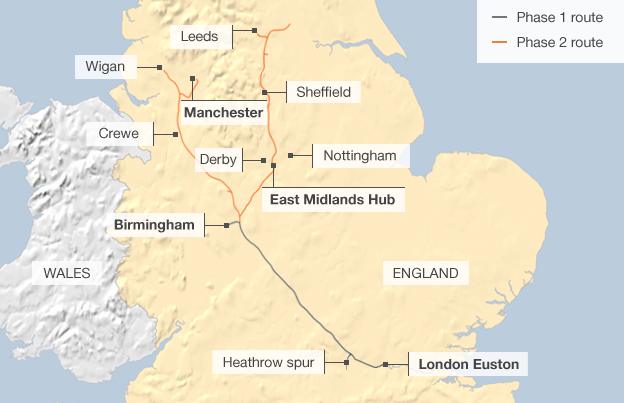
The West Midlands will gain most in absolute terms with a rise of £1.5bn-£3.1bn in output in 2037. The East Midlands will gain most in percentage terms - between 2.2% and 4.3% increase in output in 2037. The real regeneration benefit comes from shrinking journey times, external between cities in the Midlands and north of England, supporters argue.
Leeds to Birmingham is slashed from 1 hour 58 minutes to just 57 minutes. The East Midlands hub at Toton is 19 minutes from Birmingham. Manchester to Birmingham more than halves from 88 to 41 minutes.
London gains from the line (by 0.5% a year) but less than the cities on HS2 to the north, says KPMG report author Lewis Atter. "The reality is that cities compete with each other. And while London is more productive it is also more expensive." Other parts of the UK not on the line but close enough to benefit from freed up rail capacity also gain by 0.5% a year, he says. But places far away from the line - Wales for example - will probably lose out economically, he says.
Counter-argument: Academics disagree over whether high-speed rail helps or hinders deprived regions. Prof John Tomaney at University College London's Bartlett School of Planning says in France, Spain and South Korea the evidence suggests it is capitals that benefit by sucking more wealth to the centre. He believes that the main effect of HS2 is that Birmingham will become part of the South East labour market.
Two of Tomaney's colleagues at UCL disagree over the research. Prof Peter Hall and Chia-Lin Chen say the Inter-City 125 network boosted cities within two hours of London. And when the TGV brought Lille within one hour of Paris, it morphed into a knowledge-economy city.
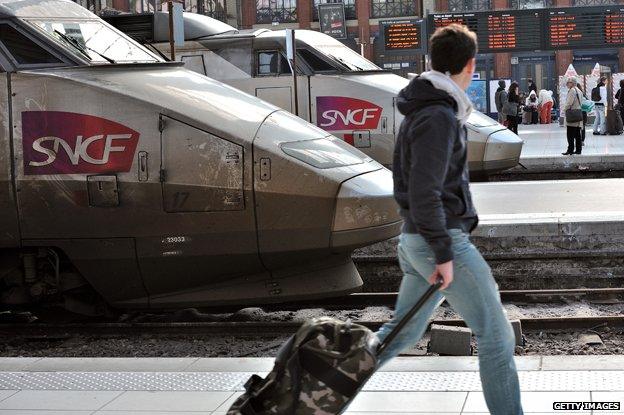
French city Lille has seen economic benefits from the TGV
But it's a mixed picture, external. "High-speed rail does not always help old one-industry cities like Doncaster and Newport. And it can boost major cities - Manchester, Leeds, Lille - at the expense of their surrounding old-industrialised regions," wrote Hall.
Tim Harford, author of the Undercover Economist Strikes Back, says history does not support HS2's regeneration claims. From the horse and cart onwards, transport improvements tend to lead to urbanisation and a greater concentration of wealth. So will HS2 have this effect? "Pure theory makes it hard to know. But experience suggests we'll see more agglomeration," says Harford. He believes it would make more sense to improve transport between northern cities rather than include London.
The most ingenious suggestion - made by think tank the Institute for Public Policy Research - is to reverse the construction phases, external.
Begin with the V-shaped line linking Manchester and Leeds with Birmingham. London to Birmingham could be added later. It would give the north a head start and counter claims - at least initially - that the line would suck investment to the capital. Temporary upgrades on London commuter lines could be used in the interim to ward off overcrowding. Research last year showed that 89% of plans for investment in transport infrastructure have been allocated to projects in London and the South East, external. Starting in the north would redress the balance.
Against: There's no idea what the final bill will be
Until this summer, HS2 was priced at £32.7bn. But in June the government revised its estimate up by a further £10bn to a maximum of £42.6bn. Rolling stock is expected to cost another £7.5bn, external.
The Department for Transport says it will not necessarily use the entire £42.6bn, which includes a large contingency fund. It has set HS2 Ltd, the company it owns, a target price of £17.1bn for phase 1 (London to Birmingham). That contains a small contingency fund. But in case of unforeseen problems, the upper limit for phase 1 is £21.4bn, with £21.2bn for phase two. £14.4bn of the £42.6bn budget is contingency money.
The London Olympics, which organisers claim came in under budget, might make people wary. When London's bid was chosen in 2005 it was supposed to cost £2.4bn. In 2007 it was revised up to £9.35bn, external.
It ended up costing £8.77bn, less than its final budget but more than three-and-a-half times the original budget.
The Public Accounts select committee is alarmed by spiralling costs, external - from more than £16bn to £21bn plus for phase one - and the fact that contingency spending accounts for a third of the total budget.
Free market think tank the Institute for Economic Affairs (IEA) has suggested the cost could rise to £80bn. But that figure was reached by adding in lobbying from local councils for extra infrastructure and design changes.
Some Treasury officials are using the figure of £73bn - by adding VAT and inflation over the 20 year project. But this has been interpreted as being an artificial accounting method, external.
Counter-argument: Government investment in capital projects is £50bn a year, says Atter. This project is spread over 20 years so equates to just 10 months of that budget, he argues.
That's still too much for Alistair Darling, who as chancellor in the last government supported the scheme. The cost has risen too high, he wrote recently, external. "There are better ways to spend £50bn than on one line."
A Department for Transport spokeswoman dismisses "scare stories" of the project costing £70bn plus. "We need to build HS2 within or under budget. We will."
For: It will boost the UK economy

Chancellor George Osborne visits a train wheel factory in Manchester
There are no shortage of optimistic forecasts from the line's backers. It will generate 22,000 construction jobs in the next five years, external and once the entire line is running create 100,000 jobs, external.
The KPMG report estimates that within five years of the line opening, UK productivity will rise by £15bn a year (using 2013 money) - an increase of 0.8% in GDP. Better transport connections mean reduced production and transport costs, higher productivity and greater competition between UK regions, it says.
Times columnist Daniel Finkelstein cites Harvard economist Ricardo Hausmann's Atlas of Economic Complexity as evidence the line will boost growth. The theory states that the ease with which talented people can link up is a determinant of economic growth.
But both the National Audit Office and Public Accounts select committee have questioned the business case. In 2012, the government said that the benefit cost ratio (BCR) for phase 1 was estimated at 1.4. Once it becomes the full Y-shaped network it rises to 1.9, external. This means for every pound spent £1.90 is generated, external.
An alternative scheme of patching up the line would offer a better return on investment, according to a report that engineering firm Atkins produced for the government last year. It offered the taxpayer a return of £6.06 for every pound invested, external.
Lord Adonis, transport secretary in the last Labour government, says HS2's benefits are not captured by the methodology. "For transport infrastructure such as HS2, connecting densely networked population and economic centres, BCRs tend to be too pessimistic because they have difficulty in capturing wider economic benefits." The Jubilee line extension to Stratford had a BCR of 0.95, he notes.
Counter-argument: The DfT's modelling was criticised for using old data, which assumed business people did little or no work on long train journeys, external.
But mobile phones and laptops have changed that. By not taking this into account the economic boost from shorter journeys appeared to be stronger than it was, critics say. In its report KPMG sought to address this oversight by cutting the time value gain by 50%. If you factor this in, the economic boost to UK plc decreases from £15bn to £12bn it says.
The KPMG figures are controversial. The HS2 Action Alliance, which campaigns against the project, says there is no independent, peer-reviewed research backing up KPMG's £15bn figure. BBC business editor Robert Peston has called them "spuriously precise". KPMG's forecasts assume that the biggest impediment to narrowing the economic divide between north and south is poor transport. It ignores the impact of other hard-to-calculate factors like skill shortages and lack of developable land, Peston argued.
Against: The demolition of homes and damage to rural England is too costly and disruptive
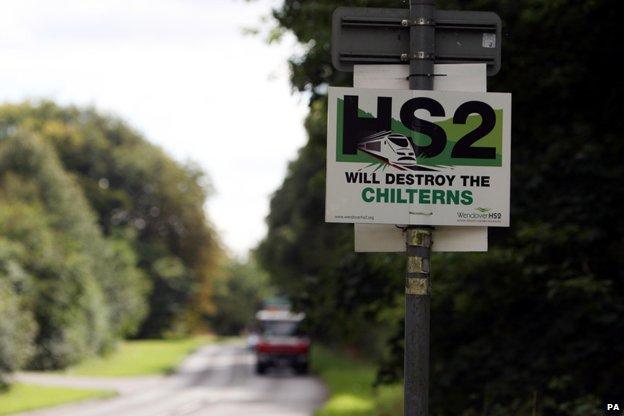
The most disrupted area in the country will be to the north of London's Euston station. More than half of the properties affected by the scheme between London and Birmingham are in and around Camden.
Across the entire line more than 600 homes will be bulldozed and another 340 homes will be cut off from their wider neighbourhood, external. Infrastructure supporting the line will be built on 250 acres of green belt land. Sites of special scientific interest will be sliced through by the line.
Historic houses in Buckinghamshire and Warwickshire will be demolished or blighted by the new line, campaigners say, external.
Homeowners will get the "unblighted" market value of their property, plus 10% (up to £47,000) and moving costs. But campaigners said the money will help only a "tiny fraction" of people.
Counter-argument: HS2 Ltd says it has already tweaked the line to reduce the number of people affected. More tunnels have been added. Around 22.5 miles (36km) of the phase 1 route will now be completely enclosed in tunnel. That is 18% of the 140 miles of rail from London to Birmingham.
HS2 Ltd says that about 60 properties on the proposed phase 1 route are likely to experience levels of noise which will qualify for noise insulation under the Noise Insulation Regulations. The number of properties that may experience a noticeable increase in noise on the phase 1 route has been reduced since consultation by a third from 4,700 to around 3,100.
For: It will be good for the environment
The government claims that HS2 will move millions of air and road trips on to rail. It will open up space on the existing rail network for freight, taking hundreds of HGVs per hour off the roads, external. "High speed rail is the most efficient way of transporting people between cities," a DfT spokeswoman says. "It requires fewer stops, meaning less energy is expended on repeatedly braking and accelerating."
Counter-argument: Rail expert Christian Wolmar says the climate change case for HS2 has virtually disappeared. Few high-speed train passengers will transfer from air, he argues. Research shows that most users would otherwise have taken conventional train services, external or simply not have made the trip.
HS2 may also encourage Birmingham to London commuting. And HS2's 250mph trains will use 50% more energy than the Eurostar trains, the HS2 Action Alliance says. The 2006 Eddington transport report predicted that the value of carbon saved over a 60-year period would be £3.2bn. The carbon saving of the line (at the time priced at £33bn) was a poor return on investment, according to Eddington.
Against: There are better value projects the UK could spend the money on
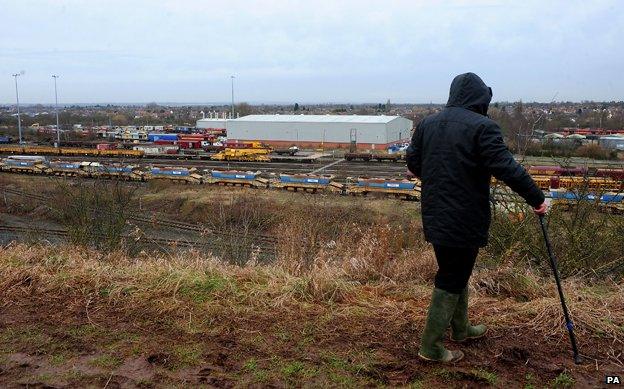
One of the strongest arguments against HS2 is the opportunity cost. Spend £50bn on HS2 and that's £50bn gone from other projects. The UK is heavily in debt, public finances are stretched so spending must be carefully prioritised. But the government has failed to compare the impact of HS2 against spending the money on other projects, external, sustainability think tank the New Economics Foundation says.
It suggests a £10bn upgrade of the East and West Coast main lines, £6bn on a bus and tram network in four core cities in the Midlands and the North, and £2bn on walking and cycling schemes.
Matt Ridley in the Times noted, external that for the cost of HS2 you could fix the nation's potholes, upgrade the existing West Coast Main Line, fix other rail bottlenecks, turn busy A-roads into dual carriageways, build a third runway at Heathrow, invest £2bn in cycle networks and provide superfast broadband across the country.
The Magazine looked at 10 other projects including the Sky Cycle scheme in London, a rail tunnel at Welwyn North and a barrage over the Severn estuary.
Counter-argument: Supporters say it's not an either or situation. Some other big schemes like the Northern Hub, external, which will speed up journeys between Manchester and Leeds, are due to go ahead anyway.
The DfT also points out that it is trebling funding for major road schemes, which could mean as many as 52 major road projects by 2020/21. It will be adding 400 lane miles of capacity to busy motorways.
And if HS2 is not given the green light, it's highly unlikely all the £42.6bn would be invested on innovative transport projects. This is a one-off opportunity to do something big and bold to the rail network, they argue.
For: The West Coast Main Line will be full by 2024
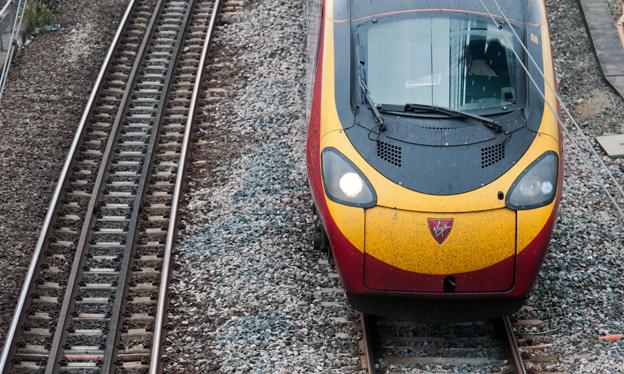
Network Rail says that by the mid 2020s the West Coast Main Line will be full. Most of the crowding will be at the southern end of the line. In 2011, during the morning peak there were on average 4,000 people standing on trains into Euston and 5,000 going into Birmingham, according to the DfT.
Last year, four of the 10 most overcrowded services across the country were London Midland services using the line. Occupancy on the line's commuter trains will grow by 26% between 2011 and 2023, Network Rail says. Demand is also projected to grow on long-distance routes, with an expected rise of 46% between London and Manchester, and 39% between London and Leeds by 2023.
Counter-argument: Question marks hang over passenger demand. The National Audit Office report of May 2013 said the DfT had not provided detailed passenger projections in its business case. And if premium prices are charged for the high-speed service will that reduce demand? HS2 Limited, the DfT owned company preparing the line, had not looked into this crucial question, external, the NAO said.
The HS2 Action Alliance points out that numbers on the WCML grew dramatically after it was upgraded in 2008. Manchester to London was cut from 2 hours 40 minutes to 2 hours eight minutes. As a result, "there has been a massive switch from air to rail with almost everyone travelling to central London now going by train", the group's briefing document says. It is a one-off change that will not be repeated, the alliance claims.
Most Virgin West Coast trains are half empty during the daytime, it says. Even in the morning peak they are only 60% full, the group says. It is the second emptiest of the main line services. The emptiest is High Speed 1, the £6.1bn line from London to Folkestone that was completed in 2007. The campaigners point to HS1 as evidence that the DfT has form in overestimating passenger numbers. Passenger numbers on HS1 from 2007 to 2011 were two-thirds of the level forecast by the DfT in 1988, according to the National Audit Office.
No campaigners argue that rail passenger growth is stalling. However, figures this month from the Office for Rail Regulation show that passenger numbers grew by 7.3% year-on-year in the period of April to June 2013. Network Rail says that it is misleading to focus on Virgin, which accounts for about 6% of services on the West Coast Main Line. The Economist's Dan Knowles say it is not just the West Coast Mainline but the whole network that needs the new line, external.
Since 1995 the number of passengers on Britain's railways has almost doubled. The amount of freight has increased by 65%. The rise in numbers defied the recession, he notes.
Against: Euston is not where the logjam is
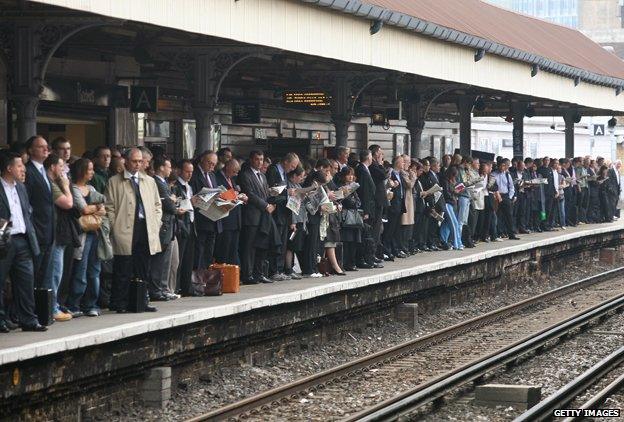
The busiest line in the UK is not the West Coast. The busiest station is not Euston. So HS2 will not tackle the real problem, opponents say.
Waterloo, Paddington, London Bridge and Liverpool Street are all far busier London stations than Euston, external, according to Network Rail figures.
The government says that HS2 will free up capacity by taking the long distance trains off existing lines and on to the new high speed line. But this will not help Waterloo, which is in south London. And there is a debate over whether the increased capacity adds up. Most of the trains packed on to commuter lines are stopping services that cannot move on to HS2. A minority are long-distance services - only about a quarter on the West Coast Main Line, according to Network Rail. Therefore its impact will only be "marginal" in relieving the existing lines, according to the HS2 Action Alliance. And marginal gains are not why you spend £50bn.
Counter-argument: Network Rail says this reading is wrong. It agrees that most trains during peak time are commuter services, and that only a few services can be moved from each existing line on to HS2. But this has a disproportionately large effect, it argues. This is because fast long-distance services and slow stopping services currently get in the way of each other.
"If everyone is travelling at the same speed you can get a lot more traffic on to the line," a spokesman for Network Rail says. "It allows us to completely recast the rail timetable." It is a technical argument that few laymen will be able to weigh in on. Network Rail says it could lead to a doubling of the number of trains at peak times on the West Coast Mainline. Milton Keynes and Watford Junction to London could go from six to 12 trains an hour. The East Coast Main Line might be freed up for services between Newcastle to Liverpool and Cambridge to Leeds, for example. On the Midland Main Line there might be new additional stops on the line between Bedford and St Albans, and more stops at Kettering and Wellingborough.
How much extra capacity HS2 will be able to free up on existing lines is a crucial question. But until a draft timetable is released, no-one knows quite what the impact, external of HS2 will be on capacity.
For: You can't boost capacity on WCML with clever tweaks and upgrades to existing lines
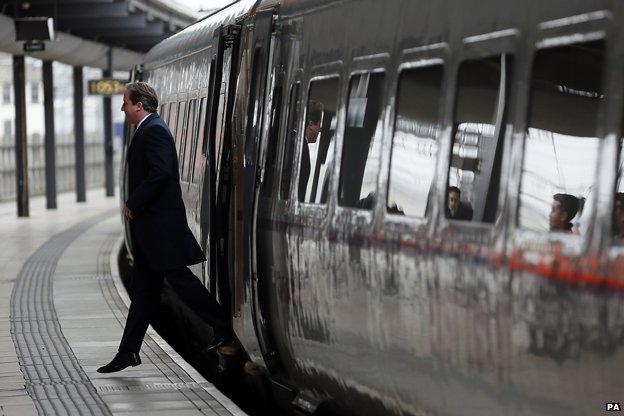
Lord Adonis says another upgrade of the West Coast Main Line is unrealistic and would soon be obsolete. "Patching and mending a 200-year-old railway, working at capacity, is hugely expensive and disruptive."
The last upgrade of the line, completed five years ago, cost £10bn, he says, external. "It entailed a decade of constant disruption to passengers and freight, and it delivered only a fraction of the capacity and connectivity of HS2."
HS2 will increase capacity from London to Birmingham by 143%, while enhancements to the existing railway would increase capacity by just 53%, a DfT spokeswoman says.
Counter-argument: A report by engineering firm Atkins suggested that an alternative proposal to HS2 - known as "51m" - would be a cheaper way of increasing long-distance capacity, external on the West Coast Main line.
It recommended longer trains, turning one first-class carriage into standard class, and specific local upgrades, such as a Stafford by-pass. It would allow more trains to leave Euston and marginally cut journey times between Birmingham and Manchester.
The HS2 Action Alliance says these improvements could be made within five years, rather than the 13 years it will take for phase 1 of HS2 to open. Network Rail says the alternative schemes do not provide sufficient capacity, external to meet forecast demand on the suburban commuter services at the south end of the WCML.
Against: High-speed is not necessary on a new line
HS2 will come in at £121m per mile, double that of Germany's Frankfurt to Cologne line, Ross Clark wrote in the Spectator, external.
"The extra cost is partly down to the higher population density of the English countryside, which requires more expense in compulsory purchase orders, but partly because it has been over-engineered." At 225mph, curves must be gentler adding to the cost of land and construction.
Counter-argument: The DfT says it might save £1.4bn by building the first phase of HS2 for conventional speed trains. "But the slower journey times - an extra 15 minutes between London and Birmingham - would reduce the benefits by £6.2 billion," a DfT spokeswoman says. "The benefit-cost ratio of building a high-speed railway rather than a conventional speed railway is therefore around 4 to 1."
For: Like the Olympics it will boost national pride and give the country a long-term national asset
The Olympics boosted national pride and gave the country a sense it could achieve something big. The government says HS2 will do the same.
Counter-argument: Others point out the Olympics legacy is not proven. And HS2 is four times the cost and could easily become an expensive white elephant. It was first proposed when the economy was booming. But the country is heavily indebted now. And many are suspicious of political grand projects.
"Politicians are always excited by 'visionary' schemes," says Alistair Darling. "One thing I have learnt is that transport, rather like banking, is at its best when it is boring. That is when it tends to work."
Against: The UK is embracing 20th Century technology just as the rest of the world turns its back on high-speed rail
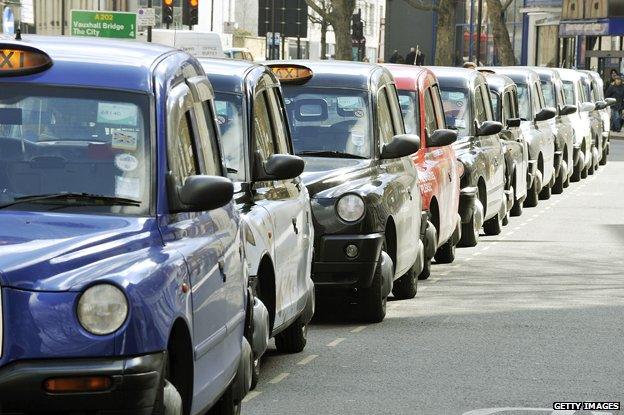
Has a taxi app made the train outdated?
Spain has the most miles of high-speed line in Europe. Its network is praised for its speed and comfort. But most experts believe that even the busiest line - from Barcelona to Madrid - loses money, external. Passenger numbers on its high speed network are rising again after a fall last year but only after aggressive price cutting, external.
France's busiest TGV lines might just break even. But even there high speed is now seen as too expensive. The French government recently cancelled new TGV projects, external in favour of overhauling its non-high speed Intercites services.
California's plan for a high-speed line is still on track - just, external.
But commentators argue that high speed rail is 20th Century technology. Video conferencing, apps like Hailo, external, and Google's driverless cars are a cheaper and more up-to-date model for doing business and getting around.
Then there's the Hyperloop scheme suggested by PayPal founder Elon Musk. He claims it could propel pressurised capsules between Los Angeles and San Francisco in 35 minutes.
Counter-argument: In Asia high-speed rail is still in vogue. China last year opened the longest high-speed line in the world and plans to double the size of its network by 2015, external.
"High speed rail is not some untested fantasy but a reality in many of the world's leading and fastest growing economies," says a DfT spokeswoman. "High speed rail is the right answer for Britain."